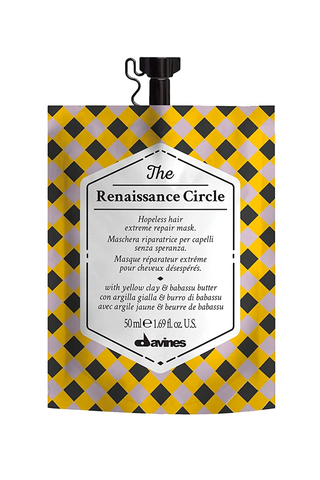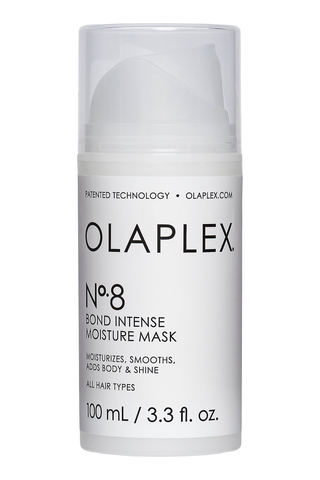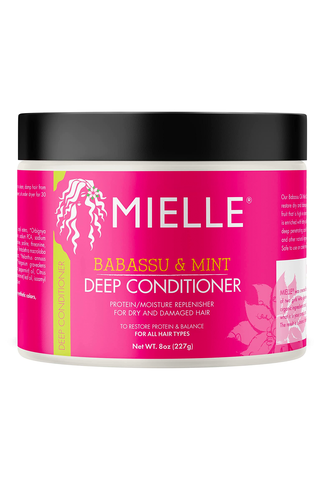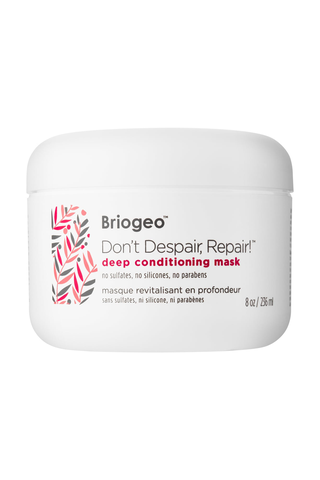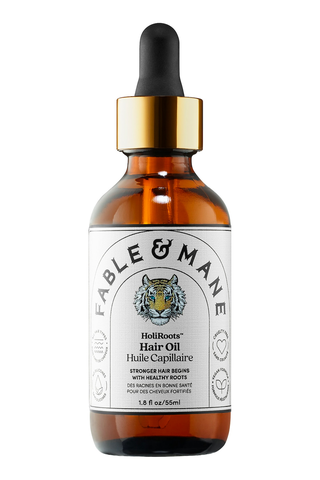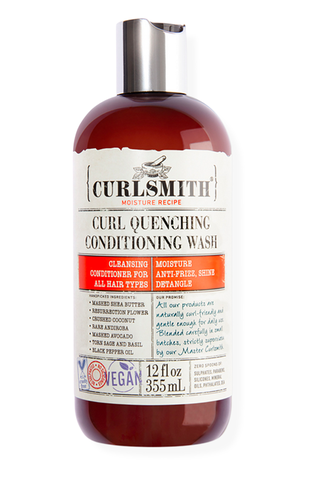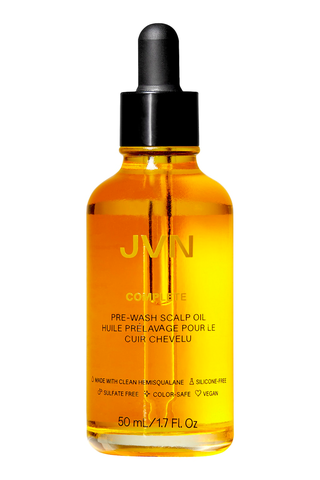PSA: "Hair Botox" Is a Thing—And It's Not What You Think

It’s almost 2023, and it feels like there’s virtually no problem that Botox can’t fix. Whether you’re dealing with forehead wrinkles, sweaty armpits, a widened jawline, or migraines, Botox seems to be every dermatologist’s go-to recommendation for a quick fix. So when I first heard of the trendy-sounding “hair botox,” I assumed it would also involve needles and pain. But surprisingly, nope: Hair botox is actually a smoothing, hydrating, and strengthening deep-conditioning treatment that doesn’t involve injections at all.
So why is it even called hair botox? And how does it compare to other at-home deep conditioners? To find out, I chatted with trichologist Bridgette Hill and hairstylist Marty Harper to get all the details on hair botox, including what it entails, how it works, and whether or not it’s safe for all hair types (I see you, curly hair folks). Keep reading to find out everything you need to know about this trending treatment.
Too lazy to get hair botox? Try one of these deep-conditioning masks instead:
What is hair botox?
Hair botox is an umbrella term used in some salons as a new way to market professional deep-conditioning treatments, which can help smooth, hydrate, and strengthen your hair, especially after a heat- or color treatment. So why is it called “botox”? Because these conditioning treatments can leave your hair somewhat smoother and softer, similar to the softening effects of Botox injections for your fine lines (again, the name is all a marketing move).
Because hair botox isn’t really “a thing”—i.e., an actual product from a manufacturer—there isn’t one specific formula with a set list of ingredients and verified claims, which means the treatment you receive will entirely depend on the salon you visit and the formulas they already use. Which also means it’s impossible to really evaluate the pros and cons of trying hair botox, because the formula (and its effects) can vary so greatly.
What’s the difference between hair botox and deep conditioner?
Hair botox (aka professional deep-conditioning treatments) is fairly similar to the deep conditioner you already have in your shower. Though, again, it’s impossible to know the exact ingredients in the salon treatment you may receive, it’s almost guaranteed to have a strengthening and damage-repairing protein base (like keratin, soy, and wheat), along with moisturizing and sealing oils, like jojoba oil, argan oil, and macadamia oil.
So why pay for the professional treatment? Because, Hill says, it usually contains more potent forms of active ingredients, like proteins and pH balancers, that you can’t get with at-home treatments. She also notes that in a salon, your stylist will be able to tailor your treatment to your hair’s needs, section by section. For example: When you lazily rake a hair mask through your hair while binging Netflix, you’re probably not taking note of where you need extra protein (like on your bleached money pieces) or extra moisture (like on your split ends or knot-prone areas). But a stylist will, and can also incorporate steam, bonnet hair dryers, and red light therapy to help the treatment penetrate more effectively.
Which is better: keratin or hair botox?
Neither keratin nor hair botox is necessarily “better,” because each depends on your hair goals and needs. Both keratin treatments and hair botox can leave your hair feeling softer, smoother, and a bit glossier, but with different strengths and permanency. “Keratin treatments contain a chemical complex to help smooth your hair,” says Harper, “while deep-conditioning treatments work to add nutrients to your hair cuticle.”
Basically, keratin treatments (which last up to three months) are great for lightly smoothing out your hair and amping up its shine, while deep-conditioning treatments (which don’t really have a measurable efficacy period) help strengthen and moisturize your hair without straightening out your curl or wave pattern.
Is hair botox good for your hair?
Yes, hair botox is good for your hair, just like all deep-conditioning treatments—both at home and in the salon—are good for your hair. Most professional smoothing treatments (like keratin or relaxers) require high heat to activate the formula, which can contribute to damage, but hair botox doesn’t require anything but itself to help “strengthen your hair, decrease frizz and breakage, and boost shine,” says Harper.
Who’s a good candidate for hair botox?
All hair types are good candidates for hair botox, because “everyone can benefit from extra moisture in their hair,” says Hill. Just make sure to first tell your stylist about daily hair regimen and come prepared with product names and—ideally—screenshots of their ingredients list. Sounds next-level, but if your salon’s hair-botox formula is filled with proteins, and you already have a protein-heavy routine (see: anti-breakage products), you run the risk of protein overload, which can lead to dry, lank, brittle, damaged hair.
Does hair botox change hair color?
Because every hair botox treatment differs by salon, it’s impossible to say whether the ingredients will have an effect on your hair color, but it’s unlikely. In general, hair botox and deep-conditioning treatments tend to be filled with moisturizing, strengthening ingredients—i.e., nothing that has the ability to strip color. So if you’ve used deep conditioners at home without any negative side effects, you’ll likely have no issues with hair botox (though, as always, chat with your stylist first).
Does hair botox ruin curls?
No, hair botox won’t “ruin” your curls. “You can’t restructure your curl pattern without breaking the bonds in your hair, and conditioning treatments like hair botox cannot do that,” says Hill. At most, your curls could look stretched out or lank if the formula is too thick and greasy for your hair, but the effect is only temporary until you shower.
What happens at a hair botox treatment?
When you go in for a hair-botox treatment, you’ll have a consultation with your stylist to determine the right treatment for your hair type (whether that’s a formula that’s lower in proteins, or lighter-weight, or more moisturizing). Once you get in the chair, your stylist will shampoo your hair, then massage the treatment through your roots to ends, letting it sit anywhere from 20 to 45 minutes. Your stylist may even have you sit under red light, steam, or a heated dryer to encourage deeper penetration of the formula.
How much does hair botox cost?
The cost of a hair botox treatment will depend on your salon, your stylist’s skill level, your location (big cities tend to cost more than small towns), your hair’s length, and your specific deep-conditioning treatment. But on average, you can expect to pay anywhere from $30 to $300.
How often should I do hair botox?
How often you do hair botox treatments will depend on your budget and your hair’s needs (like if you’re constantly damaging it with bleach and heat tools, or if you have naturally dry, high-porosity hair). But in general, Hill says clients often opt for deep-conditioning treatments three to four times a year to help keep their healthy and soft.
4 products to help you maintain your hair botox at home
How do you maintain hair botox?
How you maintain your hair botox depends on your hair texture, says Hill. If you have fine, thin hair, rinse with a micellar-water based conditioner once a week, which keeps up your smooth results without adding tons of weight to your hair. Hill recommends avoiding overdoing it on proteins for all hair types, but especially fine hair that’s prone to looking flat and stringy.
For medium-to-thick hair, Hill suggests massaging an oil-based pre-shampoo treatment through your roots and ends before washing your hair. “You’re protecting those bonds with an oil that has a molecular structure small enough to hydrate hair strands from the inside and fill in any gaps in the hair cuticle,” she says. Then, follow with a lightweight conditioner to add slip and moisture without leaving your hair weighed down.
And, as always, avoid any product or treatment that strips your hair of moisture, like shampoos with strong detergents (like sulfates), especially if you’re working with 4c hair. Instead, Hill says to “incorporate more rinses and co-washes in your routine, and follow up with an intensely hydrating hair mask.” Basically, the key to maintaining hair botox is just being really nice to your hair—which, reminder, you should be doing anyway.
Final thoughts:
Want shinier, stronger hair? You might love the results of a hair botox treatment, since there’s no such thing as too much TLC for your hair, especially when in the hands of a professional. Still, if you can’t get to a salon, or you just don’t want to spend the money, you can always incorporate a deep conditioner into your routine every other week for added smoothness and strength. Good hair days ahead, babes.
Meet the experts:
Why trust Cosmopolitan?
Beth Gillette is the beauty editor at Cosmopolitan with four years of experience researching, writing, and editing hair stories that range from the best brushes for curly hair to scalp acne shampoos. She’s an authority in all hair categories but is an expert when it comes to hair botox, thanks to interviews with experts all about the treatment. She regularly tests and analyzes hair treatments for efficacy, while working with the industry’s top trichologists and hairstylists to assess new formulas and brands.
Source: Read Full Article
